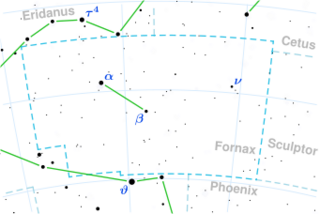Astronomy:LP 944-20
Coordinates: ![]() 03h 39m 35.22s, −35° 25′ 44.09″
03h 39m 35.22s, −35° 25′ 44.09″
| Observation data Equinox J2000.0]] (ICRS) | |
|---|---|
| Constellation | Fornax |
| Right ascension | 03h 39m 35.220s[1] |
| Declination | –35° 25′ 44.09″[1] |
| Apparent magnitude (V) | 18.69 |
| Characteristics | |
| Spectral type | M9[1] |
| Apparent magnitude (B) | ~20.17[1] |
| Apparent magnitude (I) | ~13.288[1] |
| Apparent magnitude (J) | 10.725±0.021[1] |
| Apparent magnitude (H) | 10.017±0.021[1] |
| Apparent magnitude (K) | 9.548±0.023[1] |
| Astrometry | |
| Proper motion (μ) | RA: 309.001±0.050[2] mas/yr Dec.: 269.058±0.064[2] mas/yr |
| Parallax (π) | 155.5982 ± 0.0522[2] mas |
| Distance | 20.961 ± 0.007 ly (6.427 ± 0.002 pc) |
| Absolute magnitude (MV) | 20.02 |
| Details[3] | |
| Mass | 0.06±0.04 M☉ |
| Temperature | 2650±30 K |
| Rotation | <4.5 h |
| Rotational velocity (v sin i) | 28±4 km/s |
| Age | 320 ±80 million years |
| Other designations | |
LP 944-20, SIPS J0339−3525, LEHPM 3451, 2MASSI J0339352−352544, [B2006] J033935.2−352544, APMPM J0340−3526, 2MASS J03393521-3525440, 2MASSW J0339352−352544, BRI B0337−3535, BRI 0337−3535, 2MUCD 10201, Gaia DR2 4860376345833699840 | |
| Database references | |
| SIMBAD | data |
Location of LP 944-20 in the constellation Fornax | |
LP 944-20 is a dim brown dwarf of spectral class M9 located about 21 light-years from the Solar System in the constellation of Fornax. With a visual apparent magnitude of 18.69, it has one of the dimmest visual magnitudes listed on the RECONS page.
Physical characteristics
Due to short rotational period, this young brown dwarf is displaying strong and frequent X-ray flares, and possessing a strong magnetic field reaching 135 G at the photosphere level.[3] On 15 December 1999, an X-ray flare was detected.[4][5] On 27 July 2000, radio emission (in flare and quiescence) was detected from this brown dwarf by a team of students at the Very Large Array.[6]
Observations published in 2007 showed that the atmosphere of LP 944-20 contains much lithium and that it has dusty clouds.[7]
References
- ↑ 1.0 1.1 1.2 1.3 1.4 1.5 1.6 1.7 "SIPS J0339-3525 -- Brown Dwarf (M<0.08solMass)". Centre de Données astronomiques de Strasbourg. http://simbad.u-strasbg.fr/simbad/sim-id?Ident=LP+944-20. Retrieved 2009-12-14.
- ↑ 2.0 2.1 2.2 Brown, A. G. A. (2021). "Gaia Early Data Release 3: Summary of the contents and survey properties". Astronomy & Astrophysics 649: A1. doi:10.1051/0004-6361/202039657. Bibcode: 2021A&A...649A...1G. Gaia EDR3 record for this source at VizieR.
- ↑ 3.0 3.1 Guenther, E. W.; Zapatero-Osorio, María Rosa; Mehner, A.; Martín, Eduardo L. (2009), "Short-term spectroscopic monitoring of two cool dwarfs with strong magnetic fields", Astronomy & Astrophysics 498 (1): 281–287, doi:10.1051/0004-6361/200810216, Bibcode: 2009A&A...498..281G
- ↑ Rutledge, Robert E.; Basri, Gibor; Martín, Eduardo L.; Bildsten, Lars (1 August 2000). "Chandra Detection of an X-Ray Flare from the Brown Dwarf LP 944-20". The Astrophysical Journal 538 (2): L141–L144. doi:10.1086/312817. Bibcode: 2000ApJ...538L.141R.
- ↑ "LP 944-20". http://www.solstation.com/stars/lp944-20.htm. Retrieved 2017-03-11.
- ↑ Berger, E.; Ball, S.; Becker, K. M.; Clarke, M.; Frail, D. A.; Fukuda, T. A.; Hoffman, I. M.; Mellon, R. et al. (2001-03-15). "Discovery of radio emission from the brown dwarf LP944-20". Nature 410 (6826): 338–340. doi:10.1038/35066514. PMID 11268202. Bibcode: 2001Natur.410..338B.
- ↑ Pavlenko, Ya. V.; Jones, H. R. A.; Martín, Eduardo L.; Guenther, E.; Kenworthy, M. A.; Zapatero-Osorio, María Rosa (September 2007). "Lithium in LP944-20". Monthly Notices of the Royal Astronomical Society 380 (3): 1285–96. doi:10.1111/j.1365-2966.2007.12182.x. Bibcode: 2007MNRAS.380.1285P.
External links
- "The 100 nearest star systems", Research Consortium on Nearby Stars
 |


